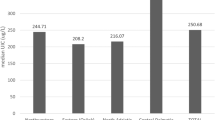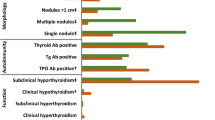Abstract
Background/Objectives:
Sweden has had a salt iodination program since 1936. This first national surveillance study on iodine nutrition infers an adequate level of urinary iodine concentration (UIC 125 μg/l) and the aim is now to evaluate thyroid volume (Tvol) in the same national sample.
Subjects/Methods:
A stratified probability proportionate to size cluster sampling was used to obtain a representative national sample of Swedish children aged 6–12 years. Median Tvol obtained ultrasonographically and the prevalence of enlarged thyroid glands were compared with an international reference standard. Regional differences were evaluated through comparisons of Tvol between coastal and inland areas, urban and rural regions, and former goitre and non-goitre regions.
Results:
Tvol was correlated with age, body surface area (BSA), weight, height and body mass index for both sexes (P<0.0001) but not with UIC. The most important predictors for Tvol were age (girls: P<0.0001, boys: P=0.001) and BSA (girls: P<0.0001, boys: P<0.01). Median Tvol was higher in Sweden than in the reference study (P<0.0001). The prevalence of goitre was higher in Sweden (correlated to age 22.3%, BSA 15.7%, weight 17.6%, height 12.9%) than in the international reference (correlated to age 2.5%, BSA 2.5%, weight 2.5%, height 2.5%) (P<0.0001). Thyroids were larger in boys from urban and former non-goitre areas.
Conclusions:
Tvols were higher in Swedish school children than in the international reference study although iodine intake is considered optimal in Sweden. These findings underline the importance of regular monitoring of iodine intake, especially with regard to the decreased intake of table salt that is likely to follow initiation of health campaigns.
This is a preview of subscription content, access via your institution
Access options
Subscribe to this journal
Receive 12 print issues and online access
$259.00 per year
only $21.58 per issue
Buy this article
- Purchase on Springer Link
- Instant access to full article PDF
Prices may be subject to local taxes which are calculated during checkout



Similar content being viewed by others
References
Andermann P, Schlogl S, Mader U, Luster M, Lassmann M, Reiners C (2007). Intra- and interobserver variability of thyroid volume measurements in healthy adults by 2D versus 3D ultrasound. Nuklearmedizin 46, 1–7.
Andersson M, Berg G, Eggertsen R, Filipsson H, Gramatkovski E, Hansson M et al. (2009). Adequate iodine nutrition in Sweden: a cross-sectional national study of urinary iodine concentration in school-age children. Eur J Clin Nutr 63, 828–834.
Brunn J, Block U, Ruf G, Bos I, Kunze WP, Scriba PC (1981). Volumetric analysis of thyroid lobes by real-time ultrasound (author's transl.). Dtsch Med Wochenschr 106, 1338–1340.
Delange F, Benker G, Caron P, Eber O, Ott W, Peter F et al. (1997). Thyroid volume and urinary iodine in European schoolchildren: standardization of values for assessment of iodine deficiency. Eur J Endocrinol 136, 180–187.
Dubois D, Dubois E (1916). Clinical calorimetry. A formula to estimate the approximate surface area if height and weight be known. Arch Intern Med 17, 863–871.
Erdogan MF (2003). Thiocyanate overload and thyroid disease. Biofactors 19, 107–111.
Greenwald I (1960). Notes on the history of goitre in Sweden. (Remarks on its significance for the aetiology of the disorder). Med Hist 4, 218–227.
Gutekunst R, Smolarek H, Hasenpusch U, Stubbe P, Friedrich HJ, Wood WG et al. (1986). Goitre epidemiology: thyroid volume, iodine excretion, thyroglobulin and thyrotropin in Germany and Sweden. Acta Endocrinol (Copenh) 112, 494–501.
Hansen PS, Brix TH, Bennedbaek FN, Bonnema SJ, Kyvik KO, Hegedus L (2004). Genetic and environmental causes of individual differences in thyroid size: a study of healthy Danish twins. J Clin Endocrinol Metab 89, 2071–2077.
Hegedus L, Rasmussen N, Knudsen N (1987). Seasonal variation in thyroid size in healthy males. Horm Metab Res 19, 391–392.
Höjer J (1931). Kropfstudien Die Verbreitung des endemischen Kropfes in Schweden. Svenska Läkarsällskapets Handlingar 57, 1–104.
Johnsson S (1965). Endemic struma—average frequency. Lakartidningen 62, 2049–2056.
Knudsen N, Bulow I, Jorgensen T, Laurberg P, Ovesen L, Perrild H (2000). Goitre prevalence and thyroid abnormalities at ultrasonography: a comparative epidemiological study in two regions with slightly different iodine status. Clin Endocrinol (Oxf) 53, 479–485.
Milakovic M, Berg G, Eggertsen R, Lindstedt G, Nystrom E (2001). Screening for thyroid disease of 15–17-year-old schoolchildren in an area with normal iodine intake. J Intern Med 250, 208–212.
Milakovic M, Berg G, Nystrom E, Lindstedt G, Gebre-Medhin M, Eggertsen R (2004). Urinary iodine and thyroid volume in a Swedish population. J Intern Med 255, 610–614.
Sjöberg K (1972). Strumasjukdomarnas Profylax Och Behandling. Thesis. Uppsala University, Sweden. pp 5–50.
Sjoberg KH (1978). Iodine and diet. Lakartidningen 75, 2477–2479.
Sjoberg KH, Sundlof G (1971). The occurrence of struma before and after iodine prophylaxis. Lakartidningen 68, 980–984.
Statistics NCBo (1969). Historical Statistics of Sweden, 1720–1967. Stockholm.
Statistics Sweden (2003). Report MIS2003:1 Orebro, Sweden, Statistics Sweden (SCB).
Svensson J, Nilsson PE, Olsson C, Nilsson JA, Lindberg B, Ivarsson SA (2004). Interpretation of normative thyroid volumes in children and adolescents: is there a need for a multivariate model? Thyroid 14, 536–543.
WHO (1995). World Health Organisation: Physical Status: The Use and Interpretation of Anthropometry. Report of a WHO Expert Committee Technical Report Series No. 854 World Health Organization: Geneva.
WHO (1997). Recommended normative values for thyroid volume in children aged 6–15 years. World Health Organization & International Council for Control of Iodine Deficiency Disorders. Bull World Health Organ 75, 95–97.
WHO (2005). Proceedings of the WHO Technical Consultation on control on iodine deficiency in pregnant women and in children, February.
World Health Organization UNCsFICftCoIDD (2007). Assessment of Iodine Deficiency Disorders and Monitoring Their Elimination. A Guide for Programme Managers 3rd edn. WHO: Geneva.
Zimmermann MB (2007). The adverse effects of mild-to-moderate iodine deficiency during pregnancy and childhood: a review. Thyroid 17, 829–835.
Zimmermann MB (2009). Iodine deficiency. Endocr Rev 30, 376–408.
Zimmermann MB, Hess SY, Molinari L, De Benoist B, Delange F, Braverman LE et al. (2004). New reference values for thyroid volume by ultrasound in iodine-sufficient schoolchildren: a World Health Organization/Nutrition for Health and Development Iodine Deficiency Study Group Report. Am J Clin Nutr 79, 231–237.
Zimmermann MB, Jooste PL, Pandav CS (2008). Iodine-deficiency disorders. Lancet 372, 1251–1262.
Acknowledgements
We thank Michael Zimmermann at the Swiss Federal Institute of Technology in Zurich, Switzerland, and Johan Svensson, the University Hospital of Malmö, Sweden for comments and for supplying data regarding thyroid volumes. We also thank Mattias Molin and Nils-Gunnar Persson for performing the statistical calculations, and the teachers, nurses and children at the participating schools in Sweden. This study was supported by the Sahlgrenska Academy at University of Gothenburg, Gothenburg, Sweden.
Author information
Authors and Affiliations
Corresponding author
Ethics declarations
Competing interests
The authors declare no conflict of interest.
Rights and permissions
About this article
Cite this article
Filipsson Nyström, H., Andersson, M., Berg, G. et al. Thyroid volume in Swedish school children: a national, stratified, population-based survey. Eur J Clin Nutr 64, 1289–1295 (2010). https://doi.org/10.1038/ejcn.2010.162
Received:
Revised:
Accepted:
Published:
Issue Date:
DOI: https://doi.org/10.1038/ejcn.2010.162
Keywords
This article is cited by
-
A randomized, double-blind study of iodine supplementation during pregnancy in Sweden: pilot evaluation of maternal iodine status and thyroid function
European Journal of Nutrition (2021)
-
Iodine deficiency in pregnant women in Sweden: a national cross-sectional study
European Journal of Nutrition (2020)
-
Correlations of water iodine concentration to earlier goitre frequency in Sweden—an iodine sufficient country with long-term iodination of table salt
Environmental Health and Preventive Medicine (2019)
-
A Paleolithic-type diet results in iodine deficiency: a 2-year randomized trial in postmenopausal obese women
European Journal of Clinical Nutrition (2018)
-
An assessment of iodine nutritional status and thyroid hormone levels in children aged 8–10 years living in Zhejiang Province, China: a cross-sectional study
European Journal of Pediatrics (2014)



